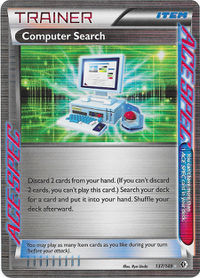PC
- This article is about the personal computers in the Pokémon world. For other uses, see PC (disambiguation).

A PC (Japanese: パソコン personal computer) is a technology used in the Pokémon games. In the core series, they are used from Generation I to VII, and in Pokémon Brilliant Diamond and Shining Pearl. They are found in every Pokémon Center, as well as in most main characters' bedrooms, in all Secret Bases in the form of a laptop, and sometimes in other buildings as well. Their primary purpose is for storing Pokémon and items.
In Pokémon Sword and Shield, they are replaced by Rotomi.
In the core series games

|
This section is incomplete. Please feel free to edit this section to add missing information and complete it. Reason: Trainer PR Videos and Photo Spot photos needed |
Features
Pokémon Storage System

- Main article: Pokémon Storage System
Every Pokémon Trainer is allowed to access a Pokémon Storage System set up by either Bill in Johto and Kanto, Lanette in Hoenn, Bebe in Sinnoh, Amanita in Unova, Cassius in Kalos, or Molayne in Alola.
Until the player meets the regional PC developer, the Pokémon Storage System option will appear as "Someone's PC", while afterwards, it will appear as the developer's PC ("Bill's PC" and so on). The player can withdraw or deposit Pokémon in a number of Boxes, allowing them to own more Pokémon than just the six permitted in their party. When a Pokémon is caught but the player's party is full, the Pokémon will be sent directly to the last Box that was accessed on the PC; from Generation III onward, if this Box is full, the Pokémon will be placed in the next free Box; in Generations I and II, the Pokémon cannot be caught in the first place.
Starting with Generation VII, the player has the option to switch out a Pokémon from the party and send it to the PC when a new Pokémon is obtained.
Pokédex evaluation
In almost all Pokémon games, the player can use a PC to have the Pokémon Professor of that game check the progress of the player's Pokédex. In Pokémon Diamond, Pearl, and Platinum, as well as in Brilliant Diamond and Shining Pearl, the professor that checks the progress of the Pokédex changes from Professor Rowan to Professor Oak upon obtaining the National Pokédex. However, in HeartGold and SoulSilver, the Pokégear serves this purpose instead. In Pokémon Sun and Moon, the Rotom Pokédex evaluates itself.
Item Storage System
In Generations I, II, and III, PCs have an Item Storage System (Japanese: どうぐのあずかりシステム tool storage system) which the player can use to store items.
In these games, the player's Bag size is very limited, with the player being unable to obtain new items if their Bag is full. From Generation IV onward, the player's Bag has enough room for at least one stack of every type of item, so the Item Storage System no longer exists.
In the Generation I and II core series games, as well as Pokémon Ruby, Sapphire, and Emerald, the Item Storage System can store 50 different types of items in their PC; in Pokémon FireRed and LeafGreen, it can store 30 different types of items.
There are some items that cannot be stored in the PC. In the Generation I and II core series games, the player can store any item in their PC. In Ruby and Sapphire, the player can store any item other than the Letter, the Devon Goods, the Red Orb, or the Blue Orb. In FireRed and LeafGreen, the player can only store items from the Items Pocket. In Emerald, the player can store any item other than HMs and Key Items.
In the Generation I and III games, the player starts the game with a Potion in their PC.
Mailbox
From Generation II to V, if the player takes Mail from a Pokémon, they can choose to either place that piece of Mail in their Mailbox or in their Bag.
Placing Mail in the Mailbox preserves the message that was written on it, allowing the player to read it later, or even give it a Pokémon again.
Ball Capsules
In the Generation IV games and Brilliant Diamond and Shining Pearl, the player can assign Seals to Ball Capsules. In the Ball Capsules menu, players can design Ball Capsules, or assign or remove Ball Capsules from Pokémon in their party. When a Pokémon is sent into battle, any Seals on its Ball Capsule will be displayed briefly.
Pokémon with a Ball Capsule cannot be stored in the PC unless the Ball Capsule is removed.
Photo Album
In HeartGold and SoulSilver, the player can take photos in various locations. The player can view, reorder, and delete their photos from the Photo Album (Japanese: フォトアルバム Photo Album) menu.
Hall of Fame
- Main article: Hall of Fame
This function only becomes accessible after defeating the Elite Four and Champion of the respective region, showing up to 25 records of the player's past victories against them. This feature was removed in Pokémon Sun and Moon.
Decorations
In bedrooms and Secret Bases, the PC allows the player to manage decorations in that room.
Saving
In Pokémon Colosseum, PCs also function as save points. This feature was removed in Pokémon XD, which retains the "save anywhere" feature of the core series games.
Networking
In FireRed and LeafGreen, it is shown that PCs require special systems to connect between two distant locations, as shown when Celio and Bill had to work together on the Network Machine to allow PCs in the Sevii Islands to be able to connect to mainland Kanto's computer network, and later to be able to connect with Lanette in Hoenn, unlocking the ability to trade Pokémon with Pokémon Ruby, Sapphire, and Emerald, as well as Colosseum and XD in Orre.
Glitches
There are several glitches associated with PCs in the Pokémon games.
- In the Generation I games, there is an invisible PC in the hotel in Celadon City, which appears very similar to a Pokémon Center. The invisible PC is located where the PC would be in a Pokémon Center.
- In the Generation I games, seeing certain glitch Pokémon such as MissingNo. will corrupt the player's Hall of Fame records.
- Many cloning glitches are related to the PC.
Gallery

|
This section is incomplete. Please feel free to edit this section to add missing information and complete it. Reason: Missing Gen VII and BDSP models. Missing BDSP interface. Other: Box, Bank, HOME? |
Sprites and models
| RBY | GSC | RSE | FRLG | DPPt | HGSS | BWB2W2 | XY | ORAS |
Interface
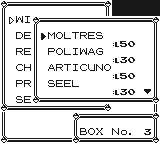
|
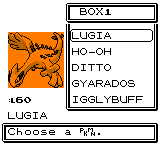
|
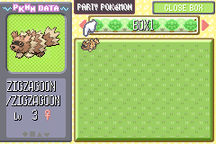
|

|

|
|---|---|---|---|---|
| RBY | GSC | RS | E | FRLG |
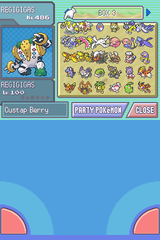
|
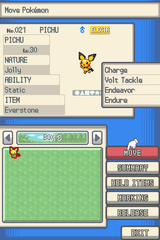
|
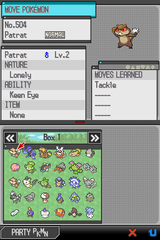
|
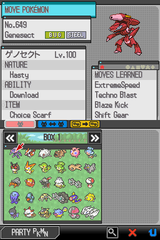
|
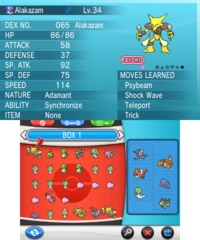
|
| DPPt | HGSS | BW | B2W2 | XY |
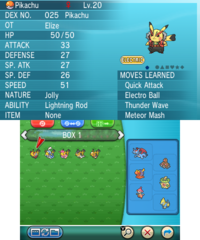
|
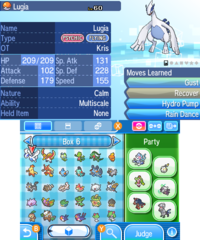
|
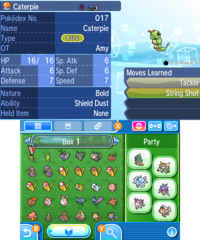
| ||
| ORAS | SM | USUM |
In the side series games
Pokémon Stadium series
- Main article: PC (Stadium)
The PC at the Pokémon Lab can be used to move items and Pokémon in Generation I and II core series games connected via Transfer Pak.
The PC features originated in Japanese Pokémon Stadium, but they were simply found in the main menu (not in a PC). All PC features can only be used with a game saved at the Pokémon Center.

|

|

|
|---|---|---|
| Arrange menu (Japanese Pokémon Stadium) |
PC (Pokémon Stadium) |
PC (Pokémon Stadium 2) |
Pokémon Colosseum and XD

|
This section is incomplete. Please feel free to edit this section to add missing information and complete it. |
Pokémon Box: Ruby & Sapphire

|
This section is incomplete. Please feel free to edit this section to add missing information and complete it. |
In the spin-off games
Pokémon Trading Card Game series
The computer is available in various places, including the Mason Laboratory, the Pokémon Dome and all Clubs in Pokémon Trading Card Game and Pokémon Trading Card Game 2: The Invasion of Team GR!.
In Pokémon Trading Card Game 2: The Invasion of Team GR!, the Minicom is a related device, accessible from the menu.
| GB1 | GB2 | English | Japanese | Notes |
|---|---|---|---|---|
| ✔ | ✔ | Card album | カードアルバム | A list of booster packs and their respective cards owned by the player. |
| ✔ | Read mail | メエルをよむ | In the first game, a list of mail received by Dr. Mason. | |
| ✔ | Deck diagnosis | デッキしんだん | Advice by Dr. Mason and the number of cards of each type in a deck. | |
| ✔ | ✔ | Glossary | ようごじてん | A glossary explaining various terms about the Trading Card Game. |
| ✔ | ✔ | プリントアウト | Use the Game Boy Printer to print decks and cards. | |
| ✔ | ✔ | Shut down | スイッチをきる | Close the PC. |
Card album
The card album displays a list of the available booster packs. If the player does not have a certain card, it is not shown. If the player does not have any cards from a booster pack, the booster pack itself is not shown.
Each booster pack screen contains a list of cards owned by the player, the number of cards owned and the maximum number of cards available. For instance, if the player has 45 cards from Evolution (whose maximum number is 50 cards), the number displayed would be "45/50".
However, the Phantom Cards only count if the player has them; otherwise they are ignored.
- In Pokémon Trading Card Game, there are 2 Phantom Cards available, so the maximum value displayed for Promotional Card is between 18 (if the player doesn't have either) and 20 cards (if the player has both).
- In Pokémon Trading Card Game 2: The Invasion of Team GR!, there are 4 Phantom Cards available, so the maximum number displayed for Promotion Card is between 45 and 49 cards.
Read mail
In the first game, contains Mail received from Dr. Mason, which are accessible only from the PC. For a complete list and transcript of all 15 Mail, see here.
In the second game, it is unavailable on the PC and replaced by the "See mailbox" option in the Minicom.
Deck diagnosis
The deck diagnosis displays a list of various advice given by Dr. Mason. The player may use the "deck check" (Japanese: デッキチェック) option to see the number of cards of each type in a deck: Energy cards, Basic Pokémon cards, Stage 1 Pokémon cards, Stage 2 Pokémon cards, and Trainer cards.
There is no official English name for "deck diagnosis" or "deck check"; these terms are fan translations from the Japanese game.
The "print" option in both games allows the player to use the Game Boy Printer to print out copies of a single card, a list depicting one of their custom deck configurations, and a list of every card they own in the game. There is a "Print quality" configuration that may be set from 1 (light) to 5 (dark).
Gallery
Sprites
| Overworld sprite (GB1) | Overworld sprite (GB2) |
Interface

|

|
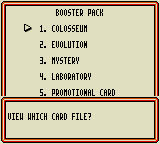
|
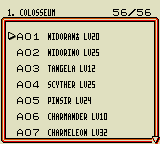
|
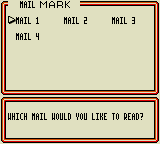
|
| PC menu (GB1) | PC menu (GB2) | Card album (GB1) | List of cards in the album (GB1) | Mail (GB1) |
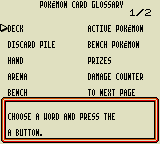
|
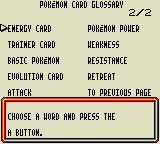
|
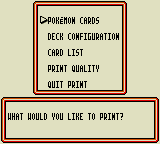
|
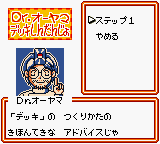
| |
| Glossary, page 1 (GB1) | Glossary, page 2 (GB1) | Print (GB1) | Deck diagnosis (GB2) |
In the anime

In the anime, the PC is not frequently used by Trainers as it is by players in the games, since most characters are shown to leave their Pokémon with a person they trust rather than using the Pokémon Storage System. Ash, for instance, tends to keep his Pokémon at Professor Oak's Laboratory, and May has left some of her Pokémon under the care of her mother, Caroline, at the Petalburg Gym.

PCs are sometimes used for communication rather than by calling on a videophone. For example, in Beauty and the Breeder, Brock is shown using an email account on the PC to keep in contact with Suzie; in Charizard's Burning Ambitions, Brock asks Liza for her email address; and in Hi Ho Silver Wind, May mentions to her mother that she keeps in touch with her friends by e-mail, in addition to phone calls and letters.
In The Ultimate Test, the people taking the Pokémon League Admissions Exam had to answer true-or-false questions on a computer as a way to test their knowledge on Pokémon. In The Ties That Bind, Ash was shown using a PC to look up Gary's profile. In Rhapsody in Drew, James used his laptop to look up information on Robert and his Pokémon.
PCs were used more often in Pokémon the Series: Diamond and Pearl. In A Stand-Up Sit-Down!, Zoey used her laptop to access the official Pokémon Contest website and show Dawn a video of a Double Performance delivered by Top Coordinator Marina. In Uncrushing Defeat!, Ash used the PC of a library inside the Lake Acuity Pokémon Center to search information on the Legendary Pokémon Uxie.
PCs were also used by Paul in Casting a Paul on Barry! to get information on Barry's Pokémon and vice-versa. It was also used by Ash in the same episode to look up info on Conway and Conway then used it to study Tobias. In addition, Nurse Joy and many officials for the Pokémon League are often shown using PCs.
In the anime, the PCs appear to run operating systems that are visually similar to Mac OS.
In the manga
Pokémon Adventures
PCs are generally used for communication purpose in Pokémon Adventures.
Red, Green & Blue arc
A PC first appeared in Gyarados Splashes In!, when Red used it to contact Professor Oak. He used another one to contact him again in Wartortle Wars.
Yellow arc
Professor Oak used a PC in Ponyta Tale to talk with Misty about Red's disappearance. Erika also used a PC in Whacked by Marowak! to ask Misty for any new information regarding Red.
Gold, Silver & Crystal arc
Before the day of his Gym Leader aptitude test, Red used a PC in his home to talk to Bill in Forretress of Solitude.
X & Y arc
In Overthrowing a Tyrunt, Bill was shown talking to Cassius over the PC.
Omega Ruby & Alpha Sapphire arc
In a flashback, Red was shown once again using the PC in his home to talk to Bill in Blastoise Transforms.
In the TCG
- Main article: Computer Search (Base Set 71)
Computer Search, a card that features a PC, was introduced as a Trainer card in the Pokémon Trading Card Game during the English Original Series (the Japanese Original Era) in the Base Set expansion, and was later reprinted in English in the Base Set 2 expansion. The card was later reprinted as an ACE SPEC Item card during the English Black & White Series (the Japanese BW Era) in the Boundaries Crossed expansion.
It also appeared in the video game Pokémon Trading Card Game as part of the Colosseum expansion, and the video game Pokémon Trading Card Game 2: The Invasion of Team GR! as part of the Island of Fossil expansion.
It allows the player to discard two cards in order to add any one card from their deck to their hand.
- Main article: Old PC (Darkness Ablaze 164)
Darkness Ablaze has the Item card Old PC, which is a PC. However, as the name implies, this one is old and broken down. It can put any card from the discard pile back into its owners hand. However, this only happens if the player gets heads results on two coin flips in a row.
Trivia
- The sprite for the PC in Generation I bears a striking resemblance to the original Apple Macintosh.
In other languages
| |||||||||||||||||||||||||||||







